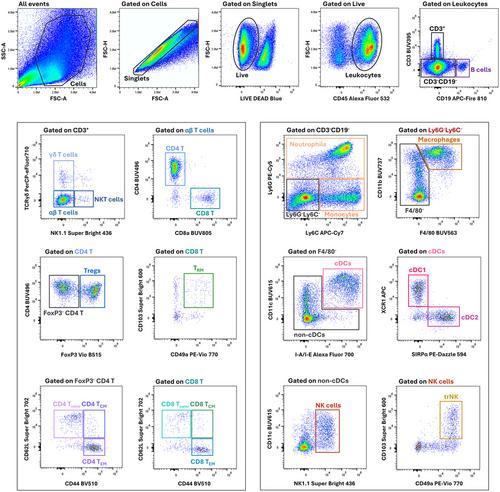{"title":"利用光谱流式细胞术鉴定正位和皮下小鼠癌症模型的抗肿瘤免疫特性","authors":"Giampiero Valenzano, Shannon N. Russell, Simei Go, Eric O'Neill, Keaton I. Jones","doi":"10.1002/cpz1.70032","DOIUrl":null,"url":null,"abstract":"<p>Mouse models remain at the forefront of immuno-oncology research, providing invaluable insights into the complex interactions between the immune system and developing tumors. While several flow cytometry panels have been developed to study cancer immunity in mice, most are limited in their capacity to address the complexity of anti-cancer immune responses. For example, many of the panels developed to date focus on a restricted number of leukocyte populations (T cells or antigen-presenting cells), failing to include the multitude of other subsets that participate in anti-cancer immunity. In addition, these panels were developed using blood or splenic leukocytes. While the immune composition of the blood or spleen can provide information on systemic immune responses to cancer, it is in the tumor microenvironment (TME) that local immunity takes place. Therefore, we optimized this spectral flow cytometry panel to identify the chief cell types that take part in cancer immunity using immune cells from cancer tissue. We used pancreatic tumors implanted both orthotopically and subcutaneously to demonstrate the panel's flexibility and suitability in diverse mouse models. The panel was also validated in peripheral immune districts (the blood, spleen, and liver of tumor-bearing mice) to allow comparisons between local and systemic anti-tumor immunity. © 2024 The Author(s). Current Protocols published by Wiley Periodicals LLC.</p><p><b>Basic Protocol 1</b>: Tumor induction—Orthotopic</p><p><b>Alternate Protocol</b>: Tumor induction—Subcutaneous</p><p><b>Basic Protocol 2</b>: Preparation of single-cell suspensions from the tumor, spleen, liver, and blood of tumor-bearing mice</p><p><b>Basic Protocol 3</b>: Staining single-cell suspensions from the tumor, spleen, liver, and blood of tumor-bearing mice</p>","PeriodicalId":93970,"journal":{"name":"Current protocols","volume":"4 10","pages":""},"PeriodicalIF":0.0000,"publicationDate":"2024-10-21","publicationTypes":"Journal Article","fieldsOfStudy":null,"isOpenAccess":false,"openAccessPdf":"https://onlinelibrary.wiley.com/doi/epdf/10.1002/cpz1.70032","citationCount":"0","resultStr":"{\"title\":\"Using Spectral Flow Cytometry to Characterize Anti-Tumor Immunity in Orthotopic and Subcutaneous Mouse Models of Cancer\",\"authors\":\"Giampiero Valenzano, Shannon N. Russell, Simei Go, Eric O'Neill, Keaton I. Jones\",\"doi\":\"10.1002/cpz1.70032\",\"DOIUrl\":null,\"url\":null,\"abstract\":\"<p>Mouse models remain at the forefront of immuno-oncology research, providing invaluable insights into the complex interactions between the immune system and developing tumors. While several flow cytometry panels have been developed to study cancer immunity in mice, most are limited in their capacity to address the complexity of anti-cancer immune responses. For example, many of the panels developed to date focus on a restricted number of leukocyte populations (T cells or antigen-presenting cells), failing to include the multitude of other subsets that participate in anti-cancer immunity. In addition, these panels were developed using blood or splenic leukocytes. While the immune composition of the blood or spleen can provide information on systemic immune responses to cancer, it is in the tumor microenvironment (TME) that local immunity takes place. Therefore, we optimized this spectral flow cytometry panel to identify the chief cell types that take part in cancer immunity using immune cells from cancer tissue. We used pancreatic tumors implanted both orthotopically and subcutaneously to demonstrate the panel's flexibility and suitability in diverse mouse models. The panel was also validated in peripheral immune districts (the blood, spleen, and liver of tumor-bearing mice) to allow comparisons between local and systemic anti-tumor immunity. © 2024 The Author(s). Current Protocols published by Wiley Periodicals LLC.</p><p><b>Basic Protocol 1</b>: Tumor induction—Orthotopic</p><p><b>Alternate Protocol</b>: Tumor induction—Subcutaneous</p><p><b>Basic Protocol 2</b>: Preparation of single-cell suspensions from the tumor, spleen, liver, and blood of tumor-bearing mice</p><p><b>Basic Protocol 3</b>: Staining single-cell suspensions from the tumor, spleen, liver, and blood of tumor-bearing mice</p>\",\"PeriodicalId\":93970,\"journal\":{\"name\":\"Current protocols\",\"volume\":\"4 10\",\"pages\":\"\"},\"PeriodicalIF\":0.0000,\"publicationDate\":\"2024-10-21\",\"publicationTypes\":\"Journal Article\",\"fieldsOfStudy\":null,\"isOpenAccess\":false,\"openAccessPdf\":\"https://onlinelibrary.wiley.com/doi/epdf/10.1002/cpz1.70032\",\"citationCount\":\"0\",\"resultStr\":null,\"platform\":\"Semanticscholar\",\"paperid\":null,\"PeriodicalName\":\"Current protocols\",\"FirstCategoryId\":\"1085\",\"ListUrlMain\":\"https://onlinelibrary.wiley.com/doi/10.1002/cpz1.70032\",\"RegionNum\":0,\"RegionCategory\":null,\"ArticlePicture\":[],\"TitleCN\":null,\"AbstractTextCN\":null,\"PMCID\":null,\"EPubDate\":\"\",\"PubModel\":\"\",\"JCR\":\"\",\"JCRName\":\"\",\"Score\":null,\"Total\":0}","platform":"Semanticscholar","paperid":null,"PeriodicalName":"Current protocols","FirstCategoryId":"1085","ListUrlMain":"https://onlinelibrary.wiley.com/doi/10.1002/cpz1.70032","RegionNum":0,"RegionCategory":null,"ArticlePicture":[],"TitleCN":null,"AbstractTextCN":null,"PMCID":null,"EPubDate":"","PubModel":"","JCR":"","JCRName":"","Score":null,"Total":0}
引用次数: 0
Using Spectral Flow Cytometry to Characterize Anti-Tumor Immunity in Orthotopic and Subcutaneous Mouse Models of Cancer
Mouse models remain at the forefront of immuno-oncology research, providing invaluable insights into the complex interactions between the immune system and developing tumors. While several flow cytometry panels have been developed to study cancer immunity in mice, most are limited in their capacity to address the complexity of anti-cancer immune responses. For example, many of the panels developed to date focus on a restricted number of leukocyte populations (T cells or antigen-presenting cells), failing to include the multitude of other subsets that participate in anti-cancer immunity. In addition, these panels were developed using blood or splenic leukocytes. While the immune composition of the blood or spleen can provide information on systemic immune responses to cancer, it is in the tumor microenvironment (TME) that local immunity takes place. Therefore, we optimized this spectral flow cytometry panel to identify the chief cell types that take part in cancer immunity using immune cells from cancer tissue. We used pancreatic tumors implanted both orthotopically and subcutaneously to demonstrate the panel's flexibility and suitability in diverse mouse models. The panel was also validated in peripheral immune districts (the blood, spleen, and liver of tumor-bearing mice) to allow comparisons between local and systemic anti-tumor immunity. © 2024 The Author(s). Current Protocols published by Wiley Periodicals LLC.
Basic Protocol 1: Tumor induction—Orthotopic
Alternate Protocol: Tumor induction—Subcutaneous
Basic Protocol 2: Preparation of single-cell suspensions from the tumor, spleen, liver, and blood of tumor-bearing mice
Basic Protocol 3: Staining single-cell suspensions from the tumor, spleen, liver, and blood of tumor-bearing mice


